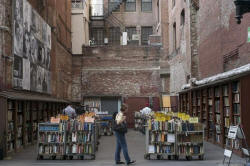|
Reading into the
millennial book-buying boom
 Send a link to a friend
Send a link to a friend
 [June 07, 2016]
By Bobbi Rebell [June 07, 2016]
By Bobbi Rebell
NEW YORK (Reuters) - (The author is a
Reuters contributor. The opinions expressed are her own.)
Nearly a decade after electronic readers revolutionized how people
read books, paperbacks and hardcovers have become cool.
"It is like a hipster movement to get back into reading," said Trish
Caudill, manager of Books-A-Million in Corbin, Kentucky. "It's
almost cult-like."
Caudill, 29, has seen a resurgence of young customers and more sales
of physical books at her store. Her peers are drawn in by graphic
novels, the "Hunger Games" and "Divergent" series, and memoirs and
essays by YouTube stars Joey Graceffa, Connor Franta and Shane
Dawson.
Millennial customers at Books-A-Million and other retailers are
missing out on online discounts at websites like Amazon.com Inc, but
they are more interested in the group experience, with the bookstore
becoming a social destination.
Across the United States, the 22-to-34 age group has become a larger
percentage of the physical book-buying demographic. It is now 37
percent of the market, up from 27 percent in 2012, according to
Nielsen Books and Consumers.

Millennials are also putting a huge chunk of their reading budget -
82 percent - into books they can hold, keep and eventually share,
according to Nielsen.
Sara Gonzalez says she does not even look at the price when she is
buying a book, even for costlier hardcovers. Part of what she says
she is paying for is being part of a community of readers.
"I'm really big about read and pass along," the 30-year-old Chicago
resident said. "Share the wealth."
Tech-obsessed younger people are finding that holding a book in
their hands can "fill an important void," said American Booksellers
Association Chief Executive Officer Oren Teicher.
That is the case for 24-year-old Kaitlyn Veach, who visits Caudill's
Books-A-Million store daily and says she spends too much there.
Veach, a married skateboard shop owner, says she wants to keep her
books forever. She shuns reading on devices and finds a thrill in
turning the pages as she gets close to the end of a book.
"I can't wait to see what happens," Veach said.
[to top of second column] |

Customers browse the used books for sale from the Brattle Book Shop
in an alley in downtown Boston, Massachusetts September 1, 2015.
REUTERS/Brian Snyder

While Veach and her peers prefer to shop in person and are willing to pay up for
that experience, buying books does not have to break the bank. In fact, books
can be one of the cheapest forms of entertainment.
One easy option: used books. Not only are they frequently sold alongside new
books at online retailers, they are also often found at various types of
secondhand stores.
Many bookstores also have membership plans or offer discounts for frequent
shoppers on new releases and other featured titles. Most stores also have
discount bins.
Many private book clubs or affinity groups have book exchanges, where members
can trade with each other.
And the ultimate social and eco-friendly way to save money on books: the public
library.
While borrowing might not help the book industry with sales figures, it could
help keep the generation reading without straining their budgets.
Gonzalez, for one, has taken note.
"I've been meaning to go" to the library, she said. "It's on my to-do list."
(Editing by Beth Pinsker and Lisa Von Ahn)
[© 2016 Thomson Reuters. All rights
reserved.] Copyright 2016 Reuters. All rights reserved. This material may not be published,
broadcast, rewritten or redistributed.
 |